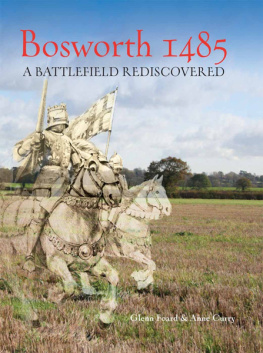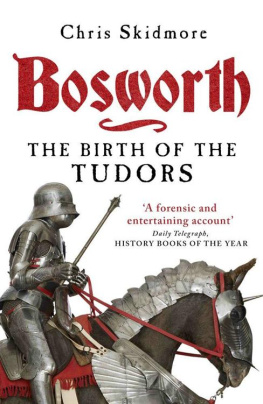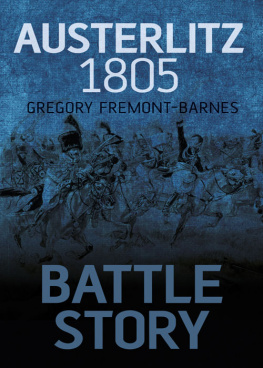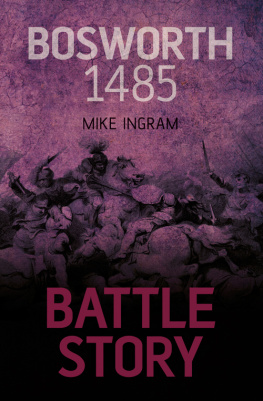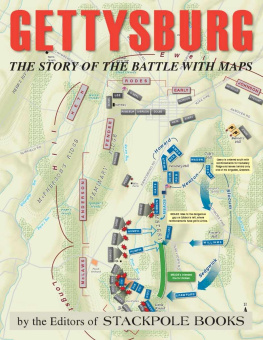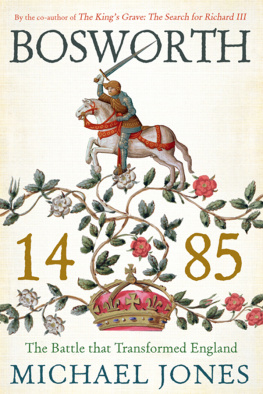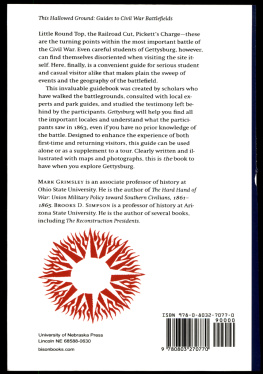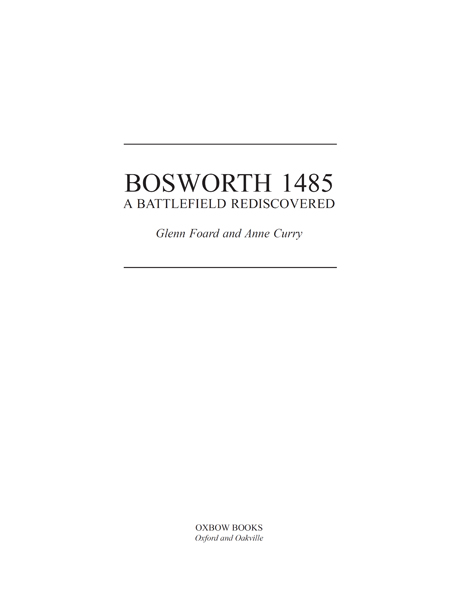Published by
Oxbow Books, Oxford, UK
Oxbow Books and the individual authors, 2013
ISBN 978-1-78297-173-3
eISBN 9781782971788
Front cover: Richard III at Bosworth (pencil drawing Graham Turner, reproduced by permission) superimposed over a view of Bosworth battlefield with the church of Stoke Golding and Crown Hill in the background (photo: Glenn Foard)
Back cover: portraits of Richard III (left) and Henry VII (right), both by unknown artists (reproduced by kind permission of the Society of Antiquaries of London). The various objects were recovered from the Bosworth battlefield area (see text for details), mostly by metal-detecting as shown in the bottom image.
This book is available direct from:
Oxbow Books, Oxford, UK
(Phone: 01865-241249; Fax: 01865-794449)
and
The David Brown Book Company
PO Box 511, Oakville, CT 06779, USA
(Phone: 860-945-9329; Fax: 860-945-9468)
or from our website
www.oxbowbooks.com
A CIP record for this book is available from the British Library
Library of Congress Cataloging-in-Publication Data
Foard, Glenn, 1953
Bosworth 1485: a battlefield rediscovered/Glenn Foard and Anne Curry.
pages cm
Includes bibliographical references and index.
ISBN 978-1-78297-173-3
1. Bosworth Field, Battle of, England, 1485. 2. Richard III, King of England, 1452-1485--Military leadership. 3. Henry VII, King of England, 1457-1509--Military leadership. 4. Great Britain--History--Richard III, 1483-1485. I. Curry, Anne. II. Title.
DA260.F63 2013
942.046--dc23
2013025688
CONTENTS
LIST OF FIGURES AND TABLES
List of Figures
Figure 7.48: Two superimposed rotational impact grooves on a lead round shot from Bosworth
List of Tables
ACKNOWLEDGEMENTS
First and foremost thanks must go to Richard Mackinder for all the day-to-day arrangements for the fieldwork, including all contact with landowners, and providing crucial assistance in most aspects of the fieldwork. Then there is the metal-detecting team without whom the site would never have been found. The core team through the key phases of the survey comprised Carl Dawson, Barry Wright, John Palmer, Pete Riley, Richard Mackinder and, last but not least, Malcolm Green, who actually discovered the battlefield when he recovered the first round shot. They were supported at various times by Pete Hartley, Lee Walkeley, Simon Richardson, Bryn Gethin, David Beaumont, Clive Kibblewhite, Lee Macfarlane, Trevor Young and others. Supervision of the team was by Pete Riley, Richard Mackinder and Glenn Foard. Finds and related work including processing, database input and photography was undertaken by Liz Blood, Sue Alderman and Ian Holloway together with substantial volunteer assistance including Ursula Blagg-Newsome, Mark Blagg-Newsome, Christine Geoghan and Brian Geoghan. Finds conservation was undertaken by Heritage Conservation, Lincoln. Finds reporting was by Richard Knox with additional advice from Wendy Scott (Portable Antiquities Officer for Leicestershire), Michael Siddons, and the staff of the Royal Armouries. Metal-detecting was conducted on Countryside Stewardship land under an agreement with DEFRA.
The documentary research on the primary sources for the battle and, to provide a wider context, for other battles and aspects of warfare during the Wars of the Roses, was undertaken by Anne Curry and Janet Dickinson. Thanks also to Michael Bletzer, Lynda Pidgeon, Matthew Strickland and John McGavin for specialist advice. Mark Page carried out the principle aspects of the search for and transcription of the written sources for the medieval landscape. Tracey Partida analysed the historic map evidence and carried out the digital mapping, produced the maps and plans for the report, and organised the digital archive. She has also produced, in GIS, all the maps for the present volume. Barry Cox undertook analysis of the place names. David Hall carried out the survey of the medieval field system and checked our translation of the Leicester Abbey survey of Stoke Golding. Rodney Burton undertook the soil survey. Ben Geary and a team from Birmingham University carried out the first phase of palaeoenvironmental analysis; Graeme Swindals and Jane Wheeler of Bradford University completed the second phase.
Derek Allsop of Cranfield University undertook experimental firing of artillery to assist in the interpretation of the roundshot and to provide data on the possible final range of the guns. This work was extended, with the assistance of Nick Hall of the Royal Armouries, who provided a small reproduction fifteenth-century artillery piece for 2 days of experimental firing. The latter was carried out with the support of Videotext Communications. Adrian Evans at Bradford University undertook pilot work on high resolution surface imaging of the lead projectiles. Rob Janaway, also at the University of Bradford, provided extensive advice and organised various soils analysis and study of the taphonomy of the battle archaeology.
Additional advice and assistance has been given by Paul Stamper and other staff of English Heritage, and by various archaeologists in Leicestershire including Peter Liddle, who was then County Archaeologist, Helen Clark and Richard Clark. Some of the documentary records for the historic terrain were previously used by Peter Foss, who provided valuable advice in the early stages of the project. Not all of his work on this had been fully used in his publications and so he kindly allowed access to copies of certain sources and to his unpublished notes. The family of Tim Parry, who died in 2006, also allowed access to his research notes. John Austin and his team, and the metal-detectorist Andrew Tansley carried out other work in an attempt to locate evidence for the suggested site in the Atherstone area. Michael Jones also provided advice on this. The following also contributed to the Bosworth Rediscovered Conference at County Hall, Leicester in February 2010: Robert Hardy, Richard Morris, the late Richard Holmes, Matthew Strickland, Anne Curry, Derek Allsop and Steven Walton.
The internal composition of the round shot from Bosworth and comparable finds from other sites in Britain were examined in 2012 using neutron tomography at the Paul Scherer Institute (PSI) in Switzerland by Sue Kilcoyne, Bob Cywinski and Amanda Wynne, all of the University of Huddersfield, assisted by Jan Hovind at PSI. 3D visualisations were produced from this data by Anders Kaestner also of PSI. 3D laser surface scanning of the artefacts was undertaken at ISIS, Harwell and by Amanda Wynne and Paul Bills at the University of Huddersfield. We are also grateful to the following for providing round shot from their fieldwork or museum collections for comparative study: Glasgow University (Flodden battlefield); CFA Archaeology and East Lothian Council (Pinkie battlefield); Towton Battlefield Project; Barnet Museum; The Mary Rose Trust. We must also thank the staff of the town museum at La Neuveville, Switzerland and the curators of the many other collections across Europe which, together with Steven Walton, we visited during 201011 seeking comparative evidence from early gun barrels. The latter research was made possible by a grant from the British Academy. Steven Walton also kindly read and corrected various errors in .
The principal funding for the Bosworth project came from the Heritage Lottery Fund, with substantial additional support from Leicestershire County Council. Further support came from the University of Leeds, where Foard was at one point Visiting Lecturer with the Institute for Medieval Studies, and the University of Southampton. In the final season of fieldwork the travel expenses for the metal-detecting volunteers were paid from LCCs Volunteers , Internships and Placements Scheme . We are also particularly grateful to the University of Huddersfield for their support from 2010 onwards towards the fieldwork programme, scientific analysis and reporting.

